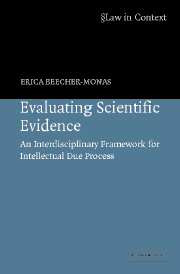Book contents
- Frontmatter
- Contents
- Acknowledgments
- Evaluating Scientific Evidence
- Introduction
- 1 Triers of science
- 2 What is intellectual due process?
- 3 A framework of analysis
- 4 Toxic torts and the causation conundrum
- 5 Criminal identification evidence
- 6 Future dangerousness testimony: The epistemology of prediction
- 7 Barefoot or Daubert? A cognitive perspective on vetting future dangerousness testimony
- 8 Future dangerousness and sexual offenders
- 9 Models of rationality: Evaluating social psychology
- 10 Evaluating battered woman syndrome
- Conclusion
- Index
- The Law in Context Series
5 - Criminal identification evidence
Published online by Cambridge University Press: 04 December 2009
- Frontmatter
- Contents
- Acknowledgments
- Evaluating Scientific Evidence
- Introduction
- 1 Triers of science
- 2 What is intellectual due process?
- 3 A framework of analysis
- 4 Toxic torts and the causation conundrum
- 5 Criminal identification evidence
- 6 Future dangerousness testimony: The epistemology of prediction
- 7 Barefoot or Daubert? A cognitive perspective on vetting future dangerousness testimony
- 8 Future dangerousness and sexual offenders
- 9 Models of rationality: Evaluating social psychology
- 10 Evaluating battered woman syndrome
- Conclusion
- Index
- The Law in Context Series
Summary
In stark contrast to the toxic tort context, judges in criminal cases overwhelmingly permit experts to testify with little or no examination of the scientific basis for their testimony – and this is true in the Commonwealth countries, the United States, and in civil law systems as well. The problem in criminal evidence is that microscopic hair analysis, bitemark identification, voice spectrography, handwriting analysis, and even such time-honored prosecutorial tools of identification as fingerprinting have crept into court with virtually no demonstration of their scientific bases. Each of these identification techniques is based on the theory that fingerprints, voice patterns, bitemarks, and other identifying evidence are uniquely personal. This is a theory based on faith (and – in the case of fingerprints, at least – some experience), not on the rigorous testing expected of scientific disciplines or required to meet the Daubert standards of admissibility.
A number of reasons have been proposed for this lackadaisical gatekeeping, but tradition undoubtedly has a strong influence here. Many of the stalwart techniques of criminal forensics crept into the courtroom nearly a century ago under the guise of science, although most had little rigorous study to support them. Judges undoubtedly fear that if rigorous gatekeeping standards were imposed now, after decades of use – and these techniques were found wanting – there would be drastic consequences for criminal justice.
- Type
- Chapter
- Information
- Evaluating Scientific EvidenceAn Interdisciplinary Framework for Intellectual Due Process, pp. 94 - 121Publisher: Cambridge University PressPrint publication year: 2006

